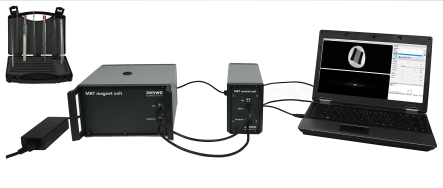setTimeout(function(){
window.print();
},500)

Technical data Spatial encoding in Nuclear Magnetic ResonanceArticle no: P5942300  Principle It should be demonstrated how spatial encoding does work in the MR technology. Experiments are executed with a MRT training device giving the opportunity ton investigate some small probes in the sample chamber. Device control is done with the provided software. Investigations comprise the generation of a 1D spatial encoding procedure via an additional magnetic field gradient in the driection of encoding and the visualizations of spatiotemporal T1- and T2-profiles. T1 and T2 are specific to the particular sample material and thus give important evidence for the composition of the subject of investigation. Benefits
Tasks
Learning objectives
Scope of delivery
| |||
PHYWE Systeme GmbH & Co. KG
Robert-Bosch-Breite 10 – 37079 Göttingen – Germany
www.phywe.com
Robert-Bosch-Breite 10 – 37079 Göttingen – Germany
www.phywe.com

